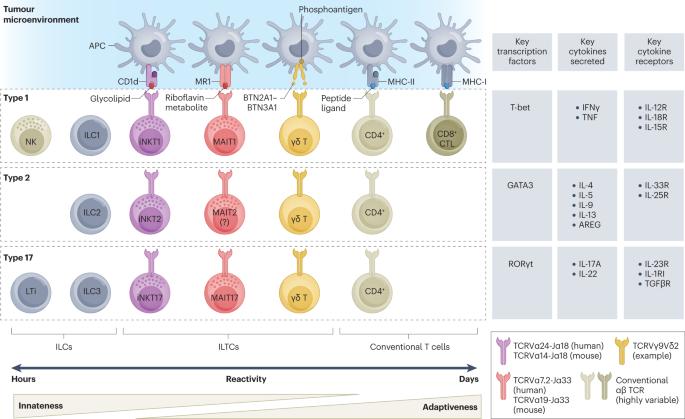Innate lymphoid cells and innate-like T cells in cancer — at the crossroads of innate and adaptive immunity
IF 72.5
1区 医学
Q1 ONCOLOGY
引用次数: 0
Abstract
Immunotherapies targeting conventional T cells have revolutionized systemic treatment for many cancers, yet only a subset of patients benefit from these approaches. A better understanding of the complex immune microenvironment of tumours is needed to design the next generation of immunotherapeutics. Innate lymphoid cells (ILCs) and innate-like T cells (ILTCs) are abundant, tissue-resident lymphocytes that have recently been shown to have critical roles in many types of cancers. ILCs and ILTCs rapidly respond to changes in their surrounding environment and act as the first responders to bridge innate and adaptive immunity. This places ILCs and ILTCs as pivotal orchestrators of the final antitumour immune response. In this Review, we outline hallmarks of ILCs and ILTCs and discuss their emerging role in antitumour immunity, as well as the pathophysiological adaptations leading to their pro-tumorigenic function. We explore the pleiotropic, in parts redundant and sometimes opposing, mechanisms that underlie the delicate interplay between the different subsets of ILCs and ILTCs. Finally, we highlight their role in amplifying and complementing conventional T cell functions and summarize immunotherapeutic strategies for targeting ILCs and ILTCs in cancer. Ruf et al. discuss the emerging roles of innate lymphoid cells and innate-like T cells in cancer immunity. The authors highlight their role in bridging adaptive and innate immunity, as well as their potential as immunotherapeutic targets.

癌症中的先天性淋巴细胞和先天性类 T 细胞--先天性免疫和适应性免疫的交叉点
以传统T细胞为靶点的免疫疗法彻底改变了许多癌症的全身治疗,但只有一部分患者能从这些方法中获益。设计下一代免疫疗法需要更好地了解肿瘤复杂的免疫微环境。先天性淋巴细胞(ILCs)和先天性类T细胞(ILTCs)是丰富的组织驻留淋巴细胞,最近的研究表明它们在多种癌症中发挥着关键作用。ILCs 和 ILTCs 能对周围环境的变化迅速做出反应,是先天性免疫和适应性免疫的第一反应者。这使 ILCs 和 ILTCs 成为最终抗肿瘤免疫反应的关键协调者。在这篇综述中,我们概述了 ILCs 和 ILTCs 的特征,讨论了它们在抗肿瘤免疫中新出现的作用,以及导致其促癌功能的病理生理适应。我们探讨了 ILCs 和 ILTCs 不同亚群之间微妙相互作用的多效性、部分冗余和有时对立的机制。最后,我们强调了它们在放大和补充传统 T 细胞功能方面的作用,并总结了针对癌症中 ILCs 和 ILTCs 的免疫治疗策略。Ruf 等人讨论了先天性淋巴细胞和先天性类 T 细胞在癌症免疫中的新作用。作者强调了它们在连接适应性免疫和先天性免疫中的作用,以及作为免疫治疗靶点的潜力。
本文章由计算机程序翻译,如有差异,请以英文原文为准。
求助全文
约1分钟内获得全文
求助全文
来源期刊

Nature Reviews Cancer
医学-肿瘤学
CiteScore
111.90
自引率
0.40%
发文量
97
审稿时长
6-12 weeks
期刊介绍:
Nature Reviews Cancer, a part of the Nature Reviews portfolio of journals, aims to be the premier source of reviews and commentaries for the scientific communities it serves. The correct abbreviation for abstracting and indexing purposes is Nat. Rev. Cancer. The international standard serial numbers (ISSN) for Nature Reviews Cancer are 1474-175X (print) and 1474-1768 (online). Unlike other journals, Nature Reviews Cancer does not have an external editorial board. Instead, all editorial decisions are made by a team of full-time professional editors who are PhD-level scientists. The journal publishes Research Highlights, Comments, Reviews, and Perspectives relevant to cancer researchers, ensuring that the articles reach the widest possible audience due to their broad scope.
 求助内容:
求助内容: 应助结果提醒方式:
应助结果提醒方式:


